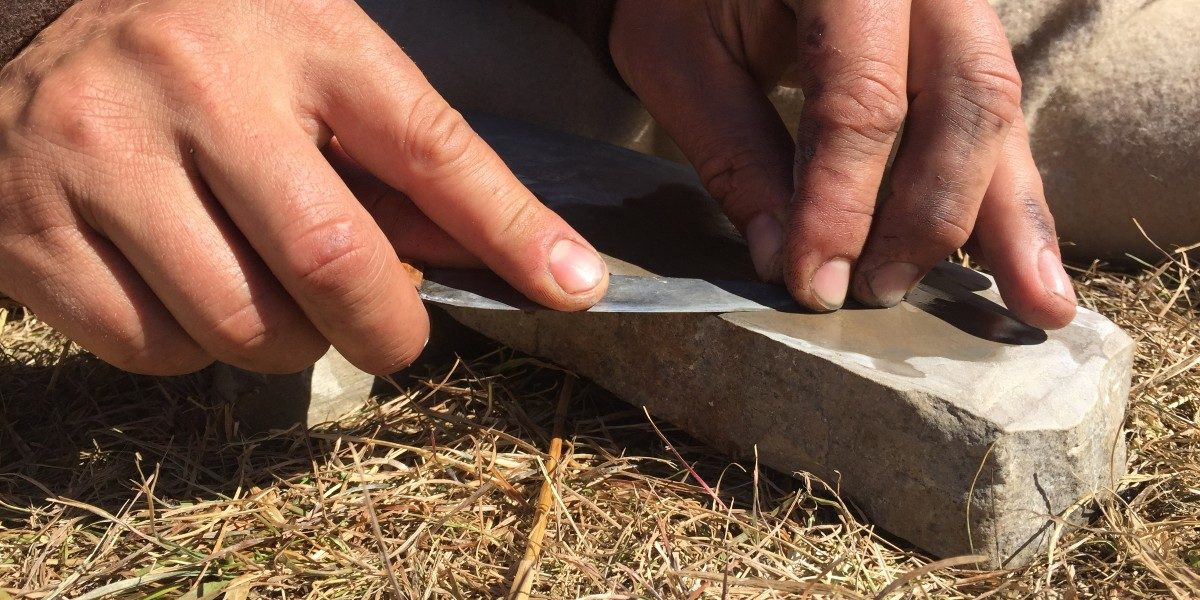Right out of the box your knife will be as sharp as it was when it left the craftsman’s table. But even the highest quality blades dull over time and repeated use. Here’s everything you need to know about how to sharpen a knife and get it back to prime cutting shape.
What kind of condition is the blade in?
First, check to see how damaged the blade is. Is it just merely dull, or are their burrs on the edge? Gently rub your thumb from the interior of the blade to the edge, feeling for any burrs or imperfections. Once you have a good idea of the condition of your blade, the next step is choosing the right whetstone.
Choose the right whetstone for the job.
Whetstones are measured the same way sandpaper is: The higher the number, the grittier the stone. If your blade is very damaged or totally dull, choose a coarse whetstone of 220 grit. For mildly dull, bump it up to 600. But if you just need to finely tune a blade that’s already in pretty good shape, use a softer stone with 1,000 grit or more.
Wet the stone.
Oil works well on most whetstones, but water will do just fine in a pinch. Lubricating the surface of a stone increases its sharpening capabilities and smooths out the path of the blade as you run it across the stone. Which leads to our next point:
Make sure your angle is right.
Here’s how to find the right angle to hold the blade as you run it across To find the right angle to run the blade over the whetstone, lay it flat against the stone and gently raise it up until you find the natural angle of the edge. Some blades have sharper angles than others. If your blade is so worn down that you can’t find the angle using this method, you’ll need to inspect it more closely in order to find it. Once you find the angle, you’ll want to keep that angle steady as you pass the blade’s edge over the stone.
Start sharpening.
Using the correct angle, and with the blade facing away from you, push the blade across the whetsone from one end to the other. Pretend you’re trying to shave a slice of the whetstone off the surface with the edge of the blade. Don’t use too much pressure. Sharpening a knife is supposed to take time and concentration, so don’t rush it, and don’t push too hard. Also, pay attention to the individual curve of the blade. Adjust the angle of the knife to ensure the entire edge gets sharpened up from heel to point. Do this a handful of times until you’re satisfied.
Flip the blade and sharpen the other side.
Once you’re satisfied with the first side, turn the blade over. Find the angle again, and gently pull the blade towards you. Repeat the sharpening process in the other direction the same number of times as the first side of the blade.
Repeat as necessary.
Sharpening a blade isn’t an exact science, and no two blades are the same. Repeat the sharpening process as needed in order to get your blade as sharp as possible.
Test it out.
The paper test is the easiest. Just grab a piece of printer paper—if you still have a printer—and just slice the paper downward with your newly sharpened knife. If it cuts cleanly, you’re done. If it catches on the paper, head back to the stone for additional sharpening.
Another way to test a blade’s sharpness is to pass it over your arm and shave off a patch of hair. You can do that if you’re into that kind of thing.
There you have it. Your blade is sharpened and ready to go. Got any extra tips for sharpening a knife? Share your thoughts in the comments below.
